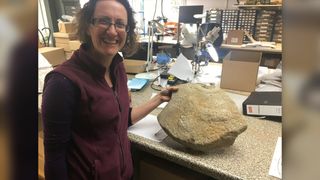Rare Roman-era phallus carving found in UK
The ancient stone on which it was found had broken.

Archaeologists in the United Kingdom have unearthed a stone carving of a giant phallus, which might have served a good luck charm at the time it was chiseled 2,000 years ago.
The Roman-era millstone — a stone used for grinding grains, such as wheat — was broken when an excavation team initially discovered it and other millstones during fieldwork in 2017 and 2018, ahead of a construction project on the A14 road, according to Oxford Archaeology, a private archaeological company in the U.K. Only recently, once archaeologists studied the broken millstone, did they realize it sported phallic imagery.
"As one of only four known examples of Romano-British millstones decorated this way, the A14 millstone is a highly significant find," Ruth Shaffrey, a worked-stone specialist at Oxford Archaeology South, said in a statement. "It offers insights into the importance of the mill to the local community and to the protective properties bestowed upon the millstone and its produce (the flour) by the depiction of a phallus on its upper surface."
Related: Image gallery: The little horny man
Archaeologists found more than 300 millstones and querns, or hand-size grain grinders, during the excavation. But this particular broken stone, found near Cambridge, caught their attention — it had two crosses engraved on it and an unusual carving on its upper face.
This stone appears to have been a phallic-decorated millstone that was broken, likely during use, and then was turned into a saddle quern, or a hand tool for stone-grinding. When the quern was constructed, the stone was flipped, which meant that the phallic carving was preserved.

Depictions of male genitalia are well known from the Roman era. For instance, in Pompeii and Israel, archaeologists have found Roman-era phallic amulets, and in Turkey, other teams have discovered Roman-era phallic jokes (depicted in a mosaic, no less) and phallic graffiti.
Sign up for the Live Science daily newsletter now
Get the world’s most fascinating discoveries delivered straight to your inbox.
"This millstone is important as it adds to the evidence for such images in Roman Britain," Steve Sherlock, Highways England's archaeology lead for the A14 project, said in the statement. "The phallus was seen as an important image of strength and virility in the Roman world, with it being common practice for legionaries to wear a phallus amulet, which would give them good luck before battle."
The newly discovered carving, as well as the other three decorated millstones found in the U.K., are detailed in an upcoming peer-reviewed study by Shaffrey in the journal Britannia.
Other discoveries from the archaeological work along the A14 include woolly mammoth tusks, woolly rhino skulls, and the earliest evidence of beer-brewing in Britain, dating to 400 B.C. Archaeologists also found the second-known gold coin in the U.K. to portray Roman emperor Laelianus, who ruled for just two months in A.D. 269 before he was killed, according to Oxford Archaeology.
Originally published on Live Science.

Laura is the archaeology and Life's Little Mysteries editor at Live Science. She also reports on general science, including paleontology. Her work has appeared in The New York Times, Scholastic, Popular Science and Spectrum, a site on autism research. She has won multiple awards from the Society of Professional Journalists and the Washington Newspaper Publishers Association for her reporting at a weekly newspaper near Seattle. Laura holds a bachelor's degree in English literature and psychology from Washington University in St. Louis and a master's degree in science writing from NYU.
